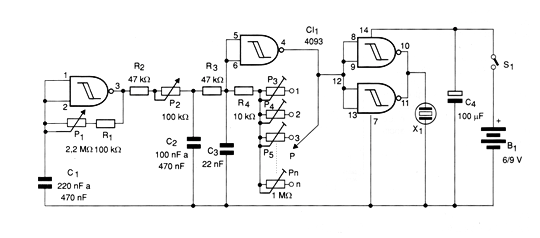In the figure we have an electronic toy organ that can both serve to amuse children as a basis for science work in schools. The main characteristic of this circuit is the vibrato effect that makes the produced note vary quickly, with a very interesting sound that can even help to obtain some simple songs. In this circuit, a first port of the 4093 (CI-1a) produces low frequency modulation or vibrato effect, adjusted by potentiometer P1. This is the “effect speed” potentiometer. The depth of the modulation, or variation of the sound is adjusted in the “depth” potentiometer P2, while the adjustments of the individual notes are made in the set of trimpots ranging from P3 to Pn. The number “n” of potentiometers cannot be very large, as it is difficult to adjust them. we recommend that the organ has only one octave. The suggested keyboard system is a probe. One end touches area of metal or copper plating that correspond to musical notes. The transducer used is a piezoelectric type for greater savings. However, a small amplifier that excites a loudspeaker can be added, in which case greater volume is obtained. The set fits in a small wooden or plastic box with the keyboard and controls on top. The power can be done with batteries or source. The source must have good filtering so that snoring does not occur during reproduction. To use it, just adjust the effect and touch the keys with the probe. Two circuits similar to this one can be used to obtain a polyphonic organ, that is, in which two keys can be played at the same time.




